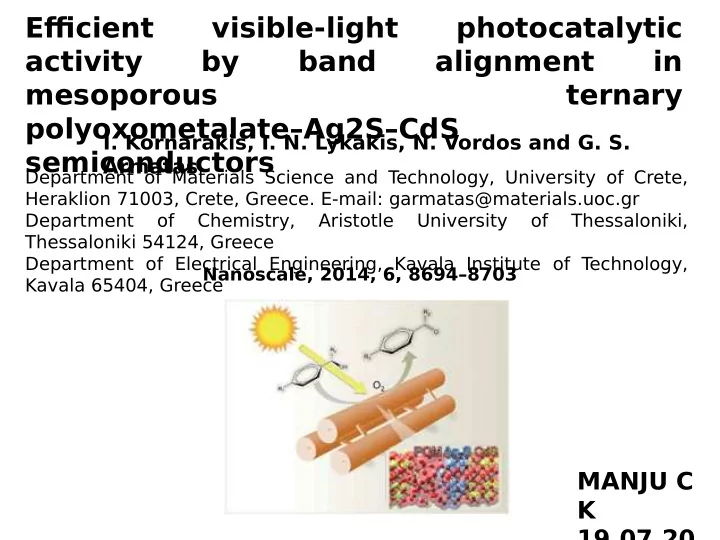

Effjcient visible-light photocatalytic activity by band alignment in mesoporous ternary polyoxometalate–Ag2S–CdS I. Kornarakis, I. N. Lykakis, N. Vordos and G. S. semiconductors Armatas Department of Materials Science and T echnology, University of Crete, Heraklion 71003, Crete, Greece. E-mail: garmatas@materials.uoc.gr Department of Chemistry, Aristotle University of Thessaloniki, Thessaloniki 54124, Greece Department of Electrical Engineering, Kavala Institute of T echnology, Nanoscale, 2014, 6, 8694–8703 Kavala 65404, Greece MANJU C K 19.07.20
Introduction • Semiconductor photocatalysis is one of the most promising catalytic processes for the synthesis of organic chemicals and degradation of environmental pollutants • Nanostructured semiconducting materials with strong light harvesting ability provide unique advantages for applications in photocatalysis. • The key steps for realizing such an extraordinary potential are the effjcient separation of electrons from holes and fast transport of photogenerated carriers to the semiconductor surface. • Among the visible light active semiconductors, such as CeO2, WO3, Fe2O3, Cu2O and Bi2S3, cadmium sulfjde (CdS) is a prospective candidate for photocatalysis due to the appropriateband edge structure which absorbs light with a wavelength shorter than 520 nm. • ssHowever, CdS shows low charge carrier separation effjciency
• In order to address these issues, difgerent strategies have been proposed including coupling of CdS with a semiconductor having a narrow or wide energy gap. As a result, the lifetime of the photogenerated carriers of the multicomponent material could become longer compared to that of individual counterparts. • T o this end, noble metal/CdS core–shell particles and hybrid nanostructures of CdS with conducting carbon and insulating silica have been established. More recently, CdS/TiO2 and CdS/ZnO binary as well as CdS/TiO2/WO3 and CdS/Au/ZnO ternary semiconductors have shown promise in visible-light photocatalytic reactions. This paper • Present the synthesis and photocatalytic activity of new hybrid mesoporous materials consisting of polyoxometalate (POM) compounds and Ag2S and CdS nanocrystals • Used various Keggin-type heteropoly acids, such as 12-phosphotungstic (H3PW12O40), 12-silicotungstic (H4SiW12O40) and 12-phosphomolybdic (H3PMo12O40) acids,
Schematic diagram showing possible electron transfer in the band structure of POM–Ag2S–CdS ternary semiconductors upon visible light irradiation (l > 420 nm) (VB: valence band, CB: conduction band, STA: SiW12O404-, PTA: PW12O403-, PMA: PMo12O403-).
Results and discussion • Mesoporous POM–Ag2S–CdS nanocomposite frameworks were prepared following a two-step chemical process. • First, CdS–POM heterostructures were grown within the pores of a silica template. In particular, employed infjltration and inversereplica solidifjcation of cadmium nitrate and thiourea compounds with polyoxometalate clusters, i.e. PW12O403-(PTA), SiW12O404- (STA) and PMo12O403- (PMA), into the pores of SBA-15 to produce three-dimensional binary CdS–POM compound semiconductors. • Subsequent dissolution of the SiO2 matrix by chemical etching led to mesoporous arrays of POM– CdS composites as a negative replica of the hard template. • Chemical transformation of POM–CdS into POM–Ag2S– CdS heterostructures was achieved via partial cation-exchange of Cd2+ with Ag+ ions
(a) SAXS and (b) XRD difgraction patterns of mesoporous CdS (i) single-phase and Ag2S–CdS (ii) PTA/Ag2S/CdS (iii) STA/Ag2S/CdS (iv) and PMA/Ag2S/CdS (v) hybrid materials. The indexing of the Bragg difgraction peaks in wide-angle XRD patterns consists of the facecentered cubic structure of CdS and the monoclinic phase of Ag2S (marked with ◊). • Mesoscopic order and crystalline structure of asprepared matrials were examined by SAXS, XRD and TEM. • All shows weak peak around 0.66-0.68 nm-1 and 1.31-1.32 nm-1. Combining with TEM it is attributed to (100) and (200) refmections of hexagonal p6mm. • Low peak intensity can be due to deformation of the hexagonal honey comp structure upon template removal. • Broad XRD peaks could be assigned to FCC CdS and some additional peaks around 34.5, 36.8, 37.6 and 40.8 are due to monoclinic Ag2s.
• Thickness of nanorods is 7-8 nm • Images shows homogeneous dispersion of Ag2s in CdS matrics. • High density region of Ag2S appears as dark and lighter regions of CdS as grey. • Interplanar spacing of 0.36 nm and 0.26 nm assigned s CdS (111) and Ag2S (12Ī) (a and b) T ypical TEM images, (c) high-resolution TEM image obtained from a thin area of the mesoporous structure and the corresponding fast-Fourier transform (FFT) patterns obtained from the darker (c-I) and brighter (c-II) regions marked by red squares, and (d) selected area electron difgraction (SAED) pattern of the mesoporous STA/Ag2S/CdS ternary semiconductor. The FFT patterns in (c-I) and (c-II) can be indexed to the [113] and [011] zone axis difgraction patterns of acanthite Ag2S and cubic CdS phases, respectively
• All isotherm shows adsorption curve associated with hysteresis loop, characteristics of mesoporous solids with interconnected porosity. • BET surface area in the range of 35-60 m2 g-1 and total pore volume 0.05-0.09 cm3 g-1 . • Non-local DFT study indicate the narrow distribution of pore size , 4.3-4.6 nm. Nitrogen adsorption–desorption isotherms and the corresponding NLDFT pore size distributions (insets) of mesoporous materials: (a) meso-CdS (black) and Ag2S–CdS (red line), (b) PTA/Ag2S/CdS, (c) STA/Ag2S/CdS and (d) PMA/Ag2S/CdS.
• Electronic spectra show sharp optical absorption at ~ 534 nm associated with band gap transition of 2.32eV. (Reported CdS) • Additional feature at 0.93 related to Ag2S. Kubelka–Munk absorption spectra of mesoporous (i) meso-CdS, (ii) Ag2S–CdS, (iii) PTA/Ag2S/CdS, (vi) STA/Ag2S/CdS and (v) PMA/ Ag2S/CdS materials.
Photocatalytic oxidation Time evolution profjles for photooxidation of 1-phenylethanol using various mesoporous CdS-based catalysts. The corresponding data for TiO2 Degussa (P25) nanoparticles are also given for comparison.
Conclusions • The synthesis of ordered mesoporous frameworksconsisting of nanocrystalline CdS and Ag2S chalcogenidesand polyoxometalate compounds (i.e., PW12O40-,SiW12O404-, PMo12O403-) via a two-step hard-templating andtopotactic ion-exchange chemical process has been reported. • The products consist of hexagonal ternary POM–Ag2S–CdSnanorod arrays and have large internal surface area anduniform pores. • Experiments showed that the intrinsic composition of POM–Ag2S–CdS plays a key role in the photocatalytic performance, in which the Ag2S and POM components function as electron shuttles in photooxidation processes, facilitating the interfacial charge carrier separation. • Compared to the Ag2S-containing samples, the STA/CuS/CdS semiconductor exhibited a signifjcant reduction in the photocatalytic activity. • Catalytic data indicated that the STA/Ag2S/CdS heterostructure,
THANK YOU
Recommend
More recommend